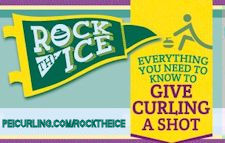Curlers at Island curling clubs are holding bonspiels and forming leagues to get ready to participate in the two-person sport of Mixed Doubles.
Curl PEI is planning to hold a Provincial Mixed Doubles Championship at the Maple Leaf Curling Club in O’Leary from Feb. 13-17 (same dates and place as the Mixed). Entries have to be in by Jan. 16, with entry fee of $100 per team. The winners of the provincial championship will advance to the 2014 Mixed Doubles Curling Trials, March 19-23, 2014 at the Ottawa Hunt & Golf Club.
Teams at the Trials in Ottawa are responsible for their own travel and accommodations as well as the entry fee of $400 per team. The entry fees collected will be returned in full as prize money. A host hotel with a preferred rate will be announced by January 1, 2014, however, choice of accommodations is up to the individual teams. Curl PEI will apply for a “team grant” from the provincial government to assist with travel expenses. Coaches are welcome and will have access to the field of play for practices and time-outs. However, there will not be a spare or alternate pool nor will alternates be allowed to compete.
The 2014 World Mixed Doubles Curling Championships will take place April 23-30 in Dumfries Scotland, in conjunction with the World Senior Men’s and Women’s Curling Championships.
Mixed Doubles Curling is new form of the traditional sport, with the following differences:
– Instead of playing in teams of four, mixed doubles curling is for teams of two players – one male and one female (no alternate/spare player is allowed).
– Teams have only six stones each (instead of eight) and one of those stones, from each team, is prepositioned on the centreline before each end of play starts.
– Player one delivers the first and last stones and player two plays the second, third and fourth stones. If they choose to, the two players may swap positions from one end to the next.
– Sweeping can be done by both team members.
– Each team receives 46 minutes of playing time and games are fixed at 8 ends – compared to 73 minutes and 10 ends for “traditional” curling.
CCA photo: Cornwall’s Veronica Smith in a Mixed Doubles mini-competition at the M&M Meat Shops Canadian Junior Curling Championships in Fort McMurray, Alta. (she lost the final of the bronze medal game in the mini-competition to her sister Sabrina)
Mixed Doubles has both a Canadian and a World championship, and is played in over 25 countries on four continents.
For a better idea on how a Mixed Doubles game works, take a look at the final, between Hungary and Sweden from last year’s Worlds in Fredericton NB:
Full Game Logistics(World Curling Federation):
(a) A team is composed of two players, one male, and one female. Alternate players are not allowed. A team must forfeit any game(s) in which it fails to have both athletes playing for the entire game. One coach will be allowed for each team.
(b) The scoring shall be the same as in a regular game of curling. The “positioned” stones that are placed before the beginning of each end are eligible to be counted in the scoring.
(c) Each game will be scheduled for eight (8) ends.
(d) Each team shall receive twenty-four (24) minutes of thinking time.
(e) When extra ends are required, the clocks will be reset, and each team shall receive three (3) minutes of thinking time for each extra end.
(f) Each team shall deliver five (5) stones per end. The player delivering the team’s first stone of the end must also deliver the team’s last stone of that end. The other team member shall deliver the team’s second, third and fourth stones for that end. The player delivering the first stone can change from end to end.
(g) Modified FGZ – No stone in play, including the “positioned” stones and those in the house, can be moved to an out-of-play position prior to the delivery of the fourth stone of an end (the fourth delivered stone is the first stone that can remove any stone from play). If there is a violation, the delivered stone shall be removed from play, and any displaced stone(s) shall be replaced to their original position by the non-offending team.
(h) Before the start of every end, one team shall instruct the game umpire to place their team’s “positioned” stone at the playing end of the sheet in one of two positions, designated A and B. The opponent’s “positioned” stone shall then be placed by the game umpire in whichever position (A or B) remains vacant. The location of these positions shall be as follows:
1) Position A: Placement so that the stone is bisected by the centre line and is either immediately in front of or immediately behind one of 3 points in the ice. The points are placed on the centre line:
§ at the mid-point between the hog line and the outermost edge of the top of the house
§ 0.915 m. (3 feet) from the mid-point closer to the house
§ 0.915 m. (3 feet) from the mid-point closer to the hog line
Based on the ice conditions, the Chief Umpire shall determine the specific placement for Position A to be used before the start of the pre-game practice and that same placement must be used for the entire game.
2) Position B: Placement so that the stone is in the back of the house, bisected by the centre line and abutting the back edge of the tee.
(i) The team having the decision on the placement of the “positioned” stones shall be:
1) Teams opposing each other in the game shall use the Last Stone Draw (LSD) to determine which team has the decision in the first end. The team with the lesser LSD distance shall have the decision on the placement.
2) Following the first end, the team that did not score shall have the decision on the placement.
3) If neither team scores in an end, the team that delivered the first stone in that end shall have the decision on placement in the next end.
(j) The team whose “positioned” stone is placed in Position A (in front of the house) shall deliver the first stone in that end, and the team whose “positioned” stone is placed in Position B (in the house) shall deliver the second stone in that end.
(k) While the team is in the process of delivery, the non-delivering player must be positioned inside the hog line and on the ice surface at the playing end of the sheet. After delivery, either or both players may sweep their delivered stone and any stones set in motion that belong to their team anywhere in front of the tee line at the playing end. This applies during all of the team’s delivered stones, including the LSD.
(l) If a player delivers a stone out of proper rotation, that stone is returned to the hack to be delivered by the correct player, after any displaced stones have been replaced to their original positions by the non-offending team. Should the infraction not be discovered until after the delivery of a subsequent stone, play continues as if the infraction had not occurred.







